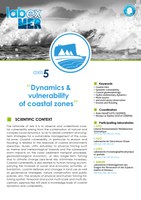Axis 5

Coordinators
Serge SUANEZ (LETG/Geomer), Nicolas LE DANTEC (LDO)
Participating laboratories
- LDO (Laboratoire Domaines Océaniques) CNRS/INSU, UBO
- LETG (Littoral Environnement Télédétection Géomatique) UBO, Nantes
- LOPS (Laboratoire océanographie physique et spatiale), CNRS, UBO, IRD, Ifremer
- AMURE (Aménagement des Usages des Ressources et des Espaces marins et littoraux) UBO, Ifremer
Scientific context
The rationale of axis 5 is to observe and understand coastal vulnerability arising from the combination of natural and complex social dynamics, so as to devise coherent and long-term strategies for a sustainable management of the coastal zone. Coastal vulnerability, in particular to erosion and flooding, is related to the response of coastal environments (beaches, dunes, cliffs, estuaries) to physical forcing such as marine and meteorological hazards and the subsequent storm impacts on the coast (sediment transport processes, geomorphological evolution), or also longer-term forcing due to climate change (sea-level rise, storminess increase). Coastal vulnerability is also related to human forcing accompanying the increase of social and economic activities, urbanization, coastal defense and changes in land use as well as governance strategies, nature conservation and public policies, etc. The analysis of physical and human forcing following spatial, temporal and social multi-scale and multi-disciplinary approaches will yield a knowledge base of coastal dynamics and vulnerability.
Roadmap
Research actions will mainly focus on:
- coastal hydrodynamics: energy dissipation ; hydro-sedimentary processes at the sediment-water interface ; role of infragravity waves and their consequences for flooding and erosion, wave-beachcliff interactions and processes involved in cliff-top storm deposits.
- coastal morphodynamics: kinematics of the shoreline ; beach/dune profile evolution ; cliff erosion, sediment fluxes ; foreshore dynamics and sediment budgets, dynamics of underwater bedforms.
- modeling: coupled hydro-morpho-sedimentary modeling on beach morphodynamics ; wave-towave modeling approach to examine the effect of transient hydrodynamic processes on sea level changes (setup, runup) and on sediment fluxes in the swash zone.
- methodological developments to add and enhance observation tools for the measurement of forcing factors and dynamics.
- implications of the occupation and uses of the coastal strip by human activities: impact of anthropogenic forcing on the natural environment.
Expected results
Expected outcomes include guidelines for the implementation of methodologies and tools of practical use for the orientation of national and local government strategies and policies regarding coastal management and defense.
More information (downloads)
NEW : 2016-2019 axis 5 roadmap
Document Actions













